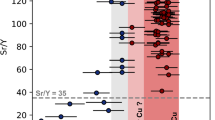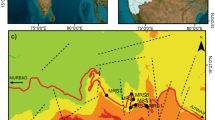Abstract
Scientific surrounding rock classification (SRC) of underground water-sealed oil reservoir caverns is greatly significant for reducing risks and costs during construction. As to underground water-sealed caverns, not only the stability and deformation of the surrounding rock, but also the requirement of the water-sealed function must be considered. At present, there is no special standard for the SRC of underground water-sealed caverns. Based on the cloud theory and principal component analysis (PCA) method, a novel analytical model was proposed for SRC of underground water-sealed caverns. Five indexes: rock strength, rock integrity, discontinuity surface characteristics, groundwater, and the angle between the horizontal plane and the main discontinuity were selected to establish a multi-index evaluating system. With enough measured samples, the weights of the five indexes were determined based on the PCA method. According to cloud theory, five indexes affecting the SRC were investigated to establish five corresponding single-index normal cloud models. Subsequently, the single-index certainty degrees to every grade of surrounding rock were calculated. Finally, combined with the weights, a multi-index certainty degree was calculated as guidance to classify the surrounding rock. The proposed novel model was applied to a case study, i.e., the first underground water-sealed oil reservoir in China. The evaluating results were in broad agreement with the excavation results. The present findings imply that the proposed novel model is an effective method for the SRC in underground water-sealed caverns and can provide some useful references to similar projects.






Similar content being viewed by others
References
Aydan O, Ulusay R, Tokashiki N (2014) A new rock mass quality rating system: rock mass quality rating (RMQR) and its application to the estimation of geomechanical characteristics of rock masses. Rock Mech Rock Eng 47:1255–1276
Barton N, Choubey V (1977) The shear strength of rock joints in theory and practice. Rock Mech 10:1–54
Barton N, Lien R, Lunde J (1974) Engineering classification of rock masses for the design of tunnel support. Rock Mech 6:189–236
Bieniawski ZT (1973) Engineering classification of jointed rock masses. Civ Eng S Afr 15(12):353–343
Bieniawski ZT (1976) Rock mass classification in rock engineering applications. In: Proceedings of a symposium on exploration for rock engineering, vol 12, pp 97–106
Bieniawski ZT, Bieniawski Z (1989) Engineering rock mass classifications: a complete manual for engineers and geologists in mining, civil, and petroleum engineering. Wiley, Hoboken
Chen CY, Wang GR (2002) Discussion on the interrelation of various rock mass quality classification systems at home and abroad. Chin J Rock Mech Eng 21:1894–1900
Deere DU, Deere DW (1988) The rock quality designation (RQD) index in practice, rock classification system for engineering purpose. In: Symposium on rock classification systems for engineering purposes, Cincinnati, 1987
Deere DU, Miller RP (1966) Engineering classification and index properties for intact rock. Illinois Univ At Urbana Dept Of Civil Engineering
Feng YG (1996) Application of grey optimal theory model in the stability classification of adjoining rock of underground construction. Chin J Geotech Eng 18:62–66
Goodman RE (1995) Block theory and its application. Géotechnique 45:383–423. https://doi.org/10.1680/geot.1995.45.3.383
Hamidi JK, Shahriar K, Rezai B, Rostami J (2010) Performance prediction of hard rock TBM using Rock Mass Rating (RMR) system. Tunn Undergr Sp Tech 25:333–345. https://doi.org/10.1016/j.tust.2010.01.008
Jolliffe IT (1986) Principal component analysis and factor analysis. In: Principal component analysis. Springer, New York
Kikuchi K, Saito K (1975) A proposed method for the classifications of rock grades in connection with bearing resistance of foundation rock. In: Proceedings of the 9th Japan symposium on rock mechanics, Tokyo, pp 66–70
Kong FM, Shang JL (2018) A validation study for the estimation of uniaxial compressive strength based on index tests. Rock Mech Rock Eng 51:1–9. https://doi.org/10.1007/s00603-018-1462-9
Lauffer H (1958) Classification for tunnel construction. Geologie und Bauwesen 24(1):46–51
Li D, Du Y (2017) Artificial intelligence with uncertainty. CRC Press, Boca Raton
Li DY, Meng HJ, Shi XM (1995) Membership clouds and membership cloud generators. J Comput Res Dev 06:15–20
Li DY, Cheung D, Shi XM, Ng V (1998) Uncertainty reasoning based on cloud models in controllers. Comput Math Appl 35:99–123. https://doi.org/10.1016/S0898-1221(97)00282-4
Li LL, Liu LX, Yang CW, Li ZG (2012) The comprehensive evaluation of smart distribution grid based on cloud model. Energy Procedia 17:96–102. https://doi.org/10.1016/j.egypro.2012.02.069
Li D, Wang S, Li D (2015) Cloud model. Spatial data mining: theory and application. Springer, Berlin, pp 187–201
Li ZQ, Xue YG, Qiu DH, Xu ZH, Zhang XL, Zhou BH, Wang XT (2017) AHP-ideal point model for large underground petroleum storage site selection: an engineering application. Sustainability-Basel 9:2343
Liu J, Wen GL, Xie YM (2015) Layout optimization of continuum structures considering the probabilistic and fuzzy directional uncertainty of applied loads based on the cloud model. Struct Multidiscip O 53:1–20
Liu J, Zhao XD, Zhang SJ, Xie LK (2018) Analysis of support requirements for underground water-sealed oil storage cavern in China. Tunn Undergr Sp Tech 71:36–46
Palmstrom A, Broch E (2006) Use and misuse of rock mass classification systems with particular reference to the Q -system. Tunn Undergr Sp Tech 21:575–593. https://doi.org/10.1016/j.tust.2005.10.005
Park ES, Jung YB, Song WK, Lee DH, Chung SK (2010) Pilot study on the underground lined rock cavern for LNG storage. Eng Geol 116:44–52
Qiu DH, Li SC, Zhang LW, Xue YG (2010) Application of GA-SVM in classification of surrounding rock based on model reliability examination. Int J Min Sci Technol 20:428–433
Ranisavljević É, Devin F, Laffly D, Nir YL (2014) A dynamic and generic cloud computing model for glaciological image processing. Int J Appl Earth Obs Geoinf 27:109–115. https://doi.org/10.1016/j.jag.2013.08.008
Saaty TL (2008) Decision making with the analytic hierarchy process. Intjservisci 1:83–98
Shen YJ, Yan RX, Yang GS, Xu GL, Wang SY (2017) Comparisons of evaluation factors and application effects of the new BQ (GSI) system with international rock mass classification systems. Geotech Geol Eng 35:2523–2548. https://doi.org/10.1007/s10706-017-0259-z
Terzaghi K (1946) Rock defects and loads on tunnel supports. Harvard Univ, Cambridge
Wang YC, Sun HY, Shang YQ, Mo Z (2010) Classification of surrounding rock based on Delphi method and ideal point method. Chin J Geotech Eng 32:651–656
Wang MW, Xu XY, Li J, Jin JL, Shen FQ (2015a) A novel model of set pair analysis coupled with extenics for evaluation of surrounding rock stability. Math Probl Eng 2015:1–9. https://doi.org/10.1155/2015/892549 (Article ID892549)
Wang ZC, Li SC, Qiao LP (2015b) Assessment of hydro-mechanical behavior of a granite rock mass for a pilot underground crude oil storage facility in China. Rock Mech Rock Eng 48:2459–2472. https://doi.org/10.1007/s00603-015-0715-0
Wang ZC, Li SC, Qiao LP, Zhang QS (2015c) Finite element analysis of the hydro-mechanical behavior of an underground crude oil storage facility in granite subject to cyclic loading during operation. Int J Rock Mech Min Sci 73:70–81. https://doi.org/10.1016/i.ijrmms.2014.09.018
Wang H, Lin H, Cao P (2017a) Correlation of UCS rating with schmidt hammer surface hardness for rock mass classification. Rock Mech Rock Eng 50:195–203
Wang X, Ren LJ, Jiao FC, Liu W (2017b) The ecological risk assessment and suggestions on heavy metals in river sediments of Jinan. Water Sci Technol 76:2177
Wang XT, Li SC, Ma XY, Xue YG, Hu J, Li ZQ (2017c) Risk Assessment of rockfall hazards in a tunnel portal section based on normal cloud model. Pol J Environ Stud 26(5):2295–2306
Wang ZC, Glais Y, Qiao LP, Huang AD, Liu J (2018) Hydro-geochemical analysis of the interplay between the groundwater, host rock and water curtain system for an underground oil storage facility. Tunn Undergr Sp Tech 71:466–477. https://doi.org/10.1016/j.tust.2017.10.001
Wickham GE, Tiedemann HR, Skinner EH (1972) Support determinations based on geologic predictions. In: Proceedings of the North American rapid excavation and tunneling conference, vol 1, pp 43–64
Wold S, Esbensen K, Geladi P (1987) Principal component analysis. Chemom Intell Lab Syst 2:37–52
Xue YG, Li ZQ, Li SC, Qiu DH, Su MX, Xu ZH, Zhou BH, Tao YF (2019a) Water inrush risk assessment for an undersea tunnel crossing a fault: an analytical model. Mar Georesour Geotec 37(7):816–827
Xue YG, Li ZQ, Qiu DH, Zhang LW, Zhao Y, Zhang XL, Zhou BH (2019b) Classification model for surrounding rock based on the PCA-ideal point method: an engineering application. B Eng Geol Environ 78(5):3627–3635
Zhang W, Li XB, Gong FQ (2008) Stability classification model of mine-lane surrounding rock based on distance discriminant analysis method. J Cent South Univ Technol 15:117–120
Zhang P, Chen JP, Qiu DH (2009) Evaluation of tunnel surrounding rock quality with extenics based on rough set. Rock Soil Mech 30:246–250
Zhang W, Chen JP, Cao ZX, Wang RY (2013) Size effect of RQD and generalized representative volume elements: a case study on an underground excavation in Baihetan dam, Southwest China. Tunn Undergr Space Technol 35:89–98
Acknowledgements
Much of the work presented in this paper was supported by the National Natural Science Foundation of China (grant 41877239, 51379112, and 41772298), and the State Key Development Program for Basic Research of China (Grant 2013CB036002), Shandong Provincial Natural Science Foundation (Grant JQ201513), China Scholarship Council (Grant 201806220196), and the program for Outstanding PhD candidate of Shandong University (Grant 201413170). The authors would like to express appreciation to the reviewers for their valuable comments and suggestions that helped improve the quality of our paper.
Author information
Authors and Affiliations
Corresponding author
Additional information
Publisher's Note
Springer Nature remains neutral with regard to jurisdictional claims in published maps and institutional affiliations.
Rights and permissions
About this article
Cite this article
Li, Z., Xue, Y., Li, S. et al. An analytical model for surrounding rock classification during underground water-sealed caverns construction: a case study from eastern China. Environ Earth Sci 78, 602 (2019). https://doi.org/10.1007/s12665-019-8606-4
Received:
Accepted:
Published:
DOI: https://doi.org/10.1007/s12665-019-8606-4




